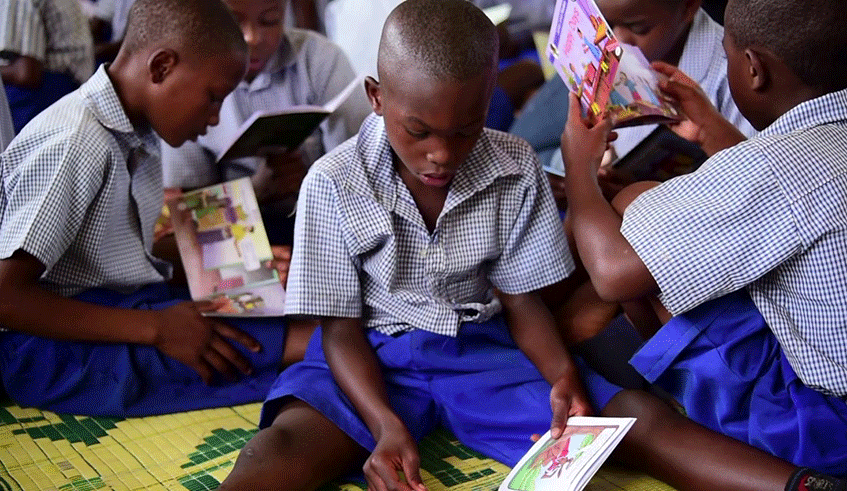

The Ministry of Education recommended a curriculum that enables schools to teach pupils from primary one to primary three exclusively in Kinyarwanda for all subjects. This was to be followed and respected by all schools. However, is this profitable to leaners?
Modeste Babonangenda, the head teacher of APADERWA School, Nyarugenge District, explains that the idea of teaching pupils in their native language helps them understand and comprehend all the concepts easily, as various examples are given about the day-to-day life which might be easy for them to relate.
He adds that examples given to learners in the local language are not easily forgotten, for instance, when a child is in an exam, they can just recall the example used by the teacher, hence remembering the concept. And this leads to excellence.
According to Isa Kiyingi, a language teacher at CCI-Essi-Nyamirambo, also in Nyarugenge, the idea of teaching kids in Kinyarwanda for the first three classes of their primary education is a great step towards the promotion of their mother tongue.
He says, with this idea, a lot of great nations have emerged, which have tried to rapidly enhance their economies using their mother languages in their education systems, though it took them a lot of strength and time.
Martha Nassolo, a teacher at Little Bears Montessori School, says through teaching and giving explanations to pupils in the local language, learners are able to know more about the importance of their culture, how they should value it and most importantly, the appropriate way to behave. Furthermore, they also obtain basic skills of writing their language and other languages as well.
On the other hand, she explains, it’s good to teach little ones two or more languages at the same time with regularity, for instance; Kinyarwanda, English and French, as a child can learn all the basics simultaneously.
Nassolo further says learners will not only be fluent and more competent if taught in Kinyarwanda, but also, the skills and concepts taught in the local language do not have to be re-taught when they transfer to a second language. In the same way, pupils automatically transfer knowledge acquired in one language to another language as soon as they have learned sufficient vocabulary in the new language.
"Additionally, though there is an official language, there is still the gap between, which is highly insignificant. For example; countries like, South and North Korea, China, Japan and some European countries, use their mother tongues to study since they created their curriculum along with their education system. When a foreign student goes there for studies, he or she may need years of prior study of the local language before they begin their courses,” Kiyingi says.
He adds, doing so will massively preserve Rwandan cultural values because a country’s language determines their traditions and norms. However, the idea might slow down the entire future education system (at least in the short run) as it may affect the current curriculum and may greatly hinder the progress of the use of English as well.
In a nutshell, this curriculum is a wonderful idea aimed at promoting Kinyarwanda as a mother tongue and a giant leap towards self-reliance, though it may workout more efficiently when done at a slow pace. Such as; from primary one then the following year, primary two, he says.
Kiyingi says that as the first curriculum is prepared, frankly, the idea’s implementation process will determine the likely level of its success in future terms, therefore; if it’s done in a wrong way, it may result into a huge failure, thus a massive damage towards the whole education system of future generations.
Enos Tumwikirize, a Kigali Parents School teacher, says teaching a concept to a student in their local language promotes quick and deeper understanding of that concept.
He explains, teaching a child in a language they comprehend helps them grasp and understand deeply. More so, a child’s interest in learning is aroused as the child picks and digests the subject matter. Therefore, teaching students in Kinyarwanda will greatly benefit them since most of them have not yet mastered the second language at Primary three level.
Nassolo says when learners speak or understand the language used to instruct them, they advance reading and writing skills faster and in a more elaborate way. Presenting reading and writing to learners in a language they speak and understand leads to great exhilaration when they discover that they can make sense of written texts and can write the names of people and things in their environment.
Barbra Kantengwa, a teacher at APAPEC-Irebero School, Gisozi, says although teaching pupils in Kinyarwanda at a young age makes it easy for them to learn and even feel comfortable to contribute in class, it might, however, make the learners too comfortable, which might hinder them from learning other languages.
Babonangenda says the native language allows learners to communicate and connect with one another, and it also creates a deeper understanding of the county’s history.
Nelson Ampuriire, a teacher at Kigali Parents School, says, "Teaching students in their local language helps them develop high thinking capacity because humans reason best and think critically in their own language. This is because their medium of communication is not so bothering during their tasks.”
Research has shown that in learning situations where both the teacher and the learner are non-native users of the language of instruction, the teacher struggles as much as the learners, particularly at the start of education. But when teaching starts in the teachers’ and learners’ local language, the experience is more natural and less stressful for all. As a result, the teacher can be more creative and innovative in designing teaching.
Tumwikirize notes, using Kinyarwanda while teaching helps learners be more engaging in the learning process.
editor@newtimesrwanda.com


